-
Welcome! The TrekBBS is the number one place to chat about Star Trek with like-minded fans.
If you are not already a member then please register an account and join in the discussion!
You are using an out of date browser. It may not display this or other websites correctly.
You should upgrade or use an alternative browser.
You should upgrade or use an alternative browser.
Donny's TOS Enterprise Interiors
- Thread starter Donny
- Start date
I think you’re right about the multitasking viewers:I've always assumed they were capable of displaying information from sensors or the computer banks as well, although we only see them used as visual intercoms.
When he says this, Tyler is shown peering intently into the viewer. Unfortunately, the shot from over his shoulder shows a lighted—but blank—miniature screen, diminishing the verisimilitude somewhat.TYLER: Captain? Reflections, sir, from the planet's surface. As I read it, they polarise out as rounded metal bits. Could be parts of a spaceship hull.
I’d post a couple of pictures, but this is the best I can do under the current state of emergency:

Ah thanks! You've solved a mystery that's been worrying me all day.I’d post a couple of pictures, but this is the best I can do under the current state of emergency:
View attachment 10513
Did GSchnitzer (or anyone else for that matter) ever reveal the origins of those gooseneck "viewers"? I've often wondered if the "housing" was merely the "shade" of a commercially available electric lamp that was compressed into the ovoid shape.
Looks like side view mirrors off cars
They put too many on the bridge early one. I like them on desks in quarters, or over a bed.
I can see a very long table, with a three way viewer in the middle--one of the large monitors on the end, and the chairman having one off to the side for a private, non-audio prompt.
Annoyingly accurate description.I’d post a couple of pictures, but this is the best I can do under the current state of emergency:
And TrekCore is back up, LLAP.
Yeah, they look like found objects to me.Looks like side view mirrors off cars[...]
Anyway, now that Trekcore is back up, here are the other places in the series you can spot the "gooseneck" viewers, or at least the "head" of them
First up in "The Menagerie" on a Starbase 11 desktop:

Beginning in Season 2, the head of one ends up tacked onto the wall of the transporter room, but its purpose there is unkown. Looks a little too high to be used as a visual readout for crewmembers. Was probably just put there to give the wall some sort of visual interest and wasn't intended to be a viewer.

Looks like it isn't just the Klingons Romulans have been sharing tech with, but also the Federation! Here is one attached to the Romulan Commander's desktop computer.
Here is one attached to the Romulan Commander's desktop computer.

First up in "The Menagerie" on a Starbase 11 desktop:

Beginning in Season 2, the head of one ends up tacked onto the wall of the transporter room, but its purpose there is unkown. Looks a little too high to be used as a visual readout for crewmembers. Was probably just put there to give the wall some sort of visual interest and wasn't intended to be a viewer.

Looks like it isn't just the Klingons Romulans have been sharing tech with, but also the Federation!
 Here is one attached to the Romulan Commander's desktop computer.
Here is one attached to the Romulan Commander's desktop computer.
VERY glad TrekCore is back up and running. Far too valuable a resource to be allowed to die.
It being down yesterday made me realize how much I take it for granted.VERY glad TrekCore is back up and running. Far too valuable a resource to be allowed to die.
In which episode does it first appear? If "Mirror Mirror", maybe it was intended to be a surveillance camera or something. If not, probably just random visual interest.Beginning in Season 2, the head of one ends up tacked onto the wall of the transporter room, but its purpose there is unkown. Looks a little too high to be used as a visual readout for crewmembers. Was probably just put there to give the wall some sort of visual interest and wasn't intended to be a viewer.

For the completists out there:I think you’re right about the multitasking viewers:
When he says this, Tyler is shown peering intently into the viewer. Unfortunately, the shot from over his shoulder shows a lighted—but blank—miniature screen, diminishing the verisimilitude somewhat.
I’d post a couple of pictures, but this is the best I can do under the current state of emergency:
View attachment 10513

It was also present in “The Changeling”, which was before “Mirror, Mirror” in both production order and televised order.In which episode does it first appear? If "Mirror Mirror", maybe it was intended to be a surveillance camera or something. If not, probably just random visual interest.
Maybe from an in-universe perspective we should imagine there's text on the little screen but we just can't make it out because it's so small?For the completists out there:
View attachment 10526

I decided to do some housekeeping tonight, and it occurred to me that I never took finished renders of both the TOS Enterprise Briefing Room and Kirk's Quarters. Sorry to post old work, but I figured you guys wouldn't mind too much 
Looking back, I'm really pleased with how the briefing room turned out, and I love the flags I included (which were from the Enterprise courtroom scenes in "The Menagerie")




Oh, and in case anyone wants to see the flag designs more carefully:


Kirk's Quarters isn't 100% done, as there are still a couple of personal props in his cabin that I never got around to model, but honestly, I think what I have is good enough for now at least. I didn't include any of the bathroom shots since it sits in a very unfinished state. Perhaps sometime soon I'll come back around and fill in the rest of the props.










I realize I also never took final screenshots of the hangar deck either, but I still have quite a bit of work to call that area complete. Hopefully I can swing back around and finish that sometime as well.

Looking back, I'm really pleased with how the briefing room turned out, and I love the flags I included (which were from the Enterprise courtroom scenes in "The Menagerie")




Oh, and in case anyone wants to see the flag designs more carefully:


Kirk's Quarters isn't 100% done, as there are still a couple of personal props in his cabin that I never got around to model, but honestly, I think what I have is good enough for now at least. I didn't include any of the bathroom shots since it sits in a very unfinished state. Perhaps sometime soon I'll come back around and fill in the rest of the props.










I realize I also never took final screenshots of the hangar deck either, but I still have quite a bit of work to call that area complete. Hopefully I can swing back around and finish that sometime as well.
Yeah, they look like found objects to me.
Found shapes are the best:
https://ericgeusz.artstation.com/
https://rcscifi.blogspot.com/search/label/dustbuster
BTW
I wonder if anyone thought to have computers draw starships--as they do portraits coming from mugshots, and the like.
https://techxplore.com/news/2019-07...48Og-EWpZtYqHPHaVS4w7Ay5sWpYtqtBybw6zg-4Qj5og
Donny, some of these look like set photos. ("Some" because some are too perfect in focus/sharpness, betraying their modern origins.) Your attention to the color gels used for that unique 60s Enterprise interior lighting is commendable.
Ya know, before I took screencaps with a film-grain post process to make them feel more "authentic", but have refrained from using it when taking new shots. I realize that we've seen fuzzy/grainy pics of these sets all of our lives, so now it's time to see them with clarity!Donny, some of these look like set photos. ("Some" because some are too perfect in focus/sharpness, betraying their modern origins.) Your attention to the color gels used for that unique 60s Enterprise interior lighting is commendable.
And with that, here are some super crisp images of the Enterprise bridge as it appeared in 2254, in the pilot episode "The Cage"!
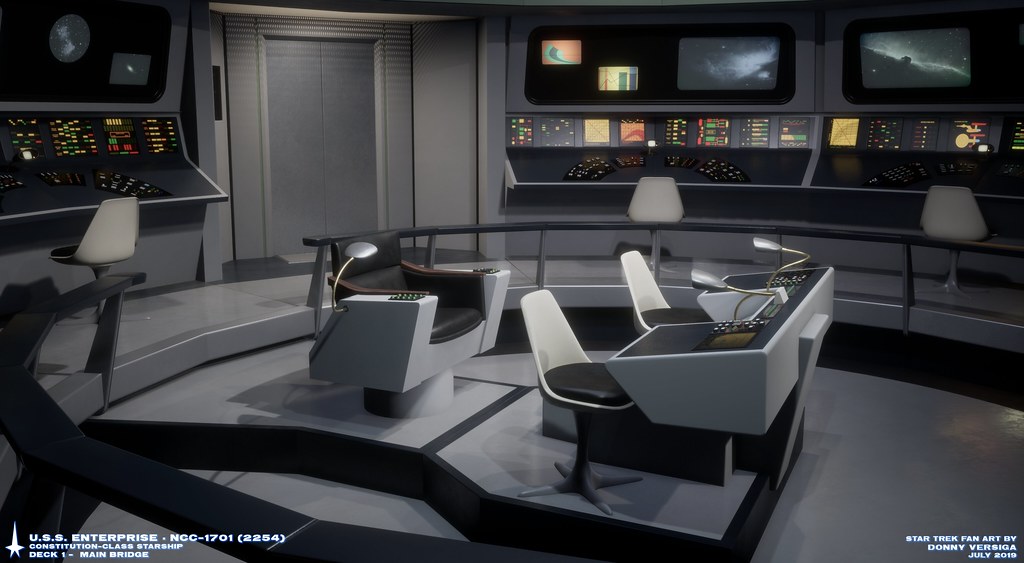

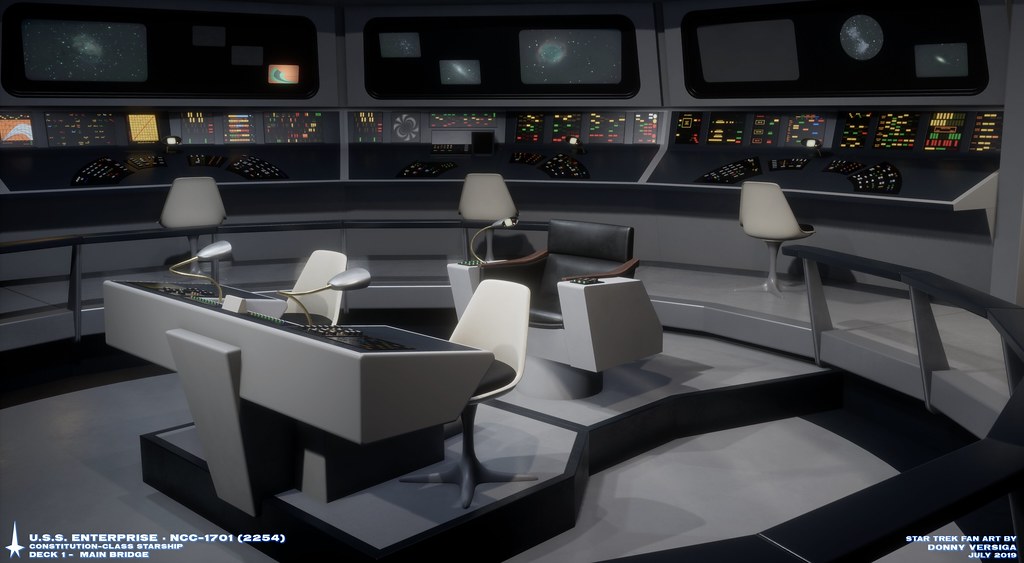

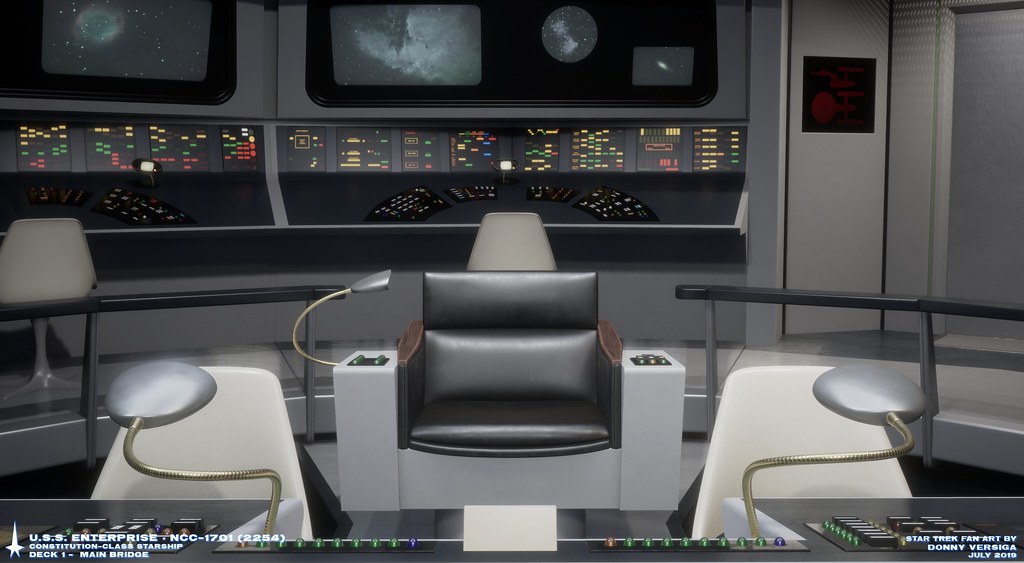
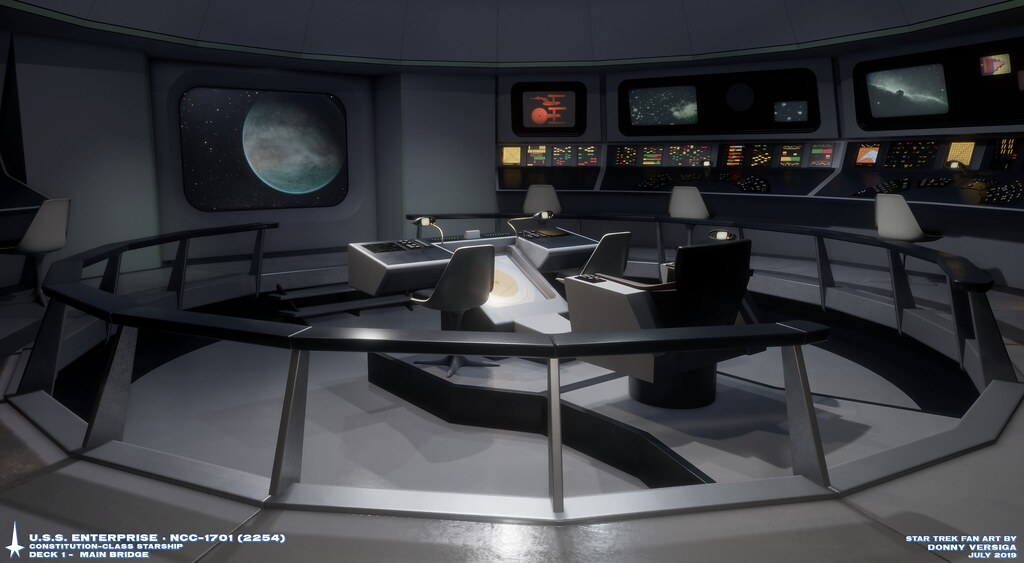

Now, to point out some obvious and not-so-obvious differences between the bridge as it appeared in "The Cage" from later apperances in "WNMHGB" and the series proper.
1) First off, you'll notice that the bridge's color palette is very monochrome, consisting mainly of grays and a very muted blue-black. This "blue-black" may be a result of the film stock used, but there's an obvious difference in the colors in the screencap below. You can see that the control panel surfaces are very black whereas the console top and library computer housing have a blue tint to them. I've chosen to reflect this blue hue in my renders, regardless of whether it actually appeared this way on set.

2) There is no carpeting on this set as there was in the series proper, as the floor appears to be a solid grey hard-surface, with a band of the dark blue-black along the perimeter of the bridge and the command pit.
3) The edges of the command pit were painted a faux-metallic silver, as was the turbolift door.
4) There is a greenish trim color lining the lower edge of the ceiling bulkheads as opposed to the macao orange of the series proper. This greenish color also appears in between some of the wall panels, like those flanking the turbolift door.
5) The large overhead viewscreens above each console are of a different configuration and color than the rest of the series. Instead of one or two large screens, some are accompained by smaller rectangular screens, or a circular screen. During "The Cage", projectionists were actually behind the bridge modules changing out these displays in certain shots. The displays generally were period photos of astronomical bodies, but in some cases they were duplicates of the other bridge displays, or graphics that were unique to "The Cage". Due to union labor laws, each screen had to be operated by its own projectionist, which deemed too expensive so this method was abandoned for the remainder of the series when static displays replaced them. I have replicated this "change-out" of screens, which is why you notice from shot to shot those displays differ, and are in some cases blank.
6) The smaller display screens at eye-level of each perimeter station remain unchanged throughout the remainder of the series. These are actually one of the only aspects of the bridge that was not changed throughout the entire run of TOS, including its pilots.
7) The Burke chairs obviously do not have their added leather backs or their 3 planted-on triangular shaped pieces on the rear of the seat, nor are they painted the light blue like they appear in the series proper.
8) Each station on the bridge has a "goose-neck" viewer attached to it. These were used in the episode as intercom units (and one could surmise data readouts as well). These remained in WNMHGB except for the helm, and were gone completely from the bridge for the series itself when they were replaced at every station by the flat TOS intercom units.
10) The viewscreen was obviously different than we saw in the series. It's corners are rounded, and is inset into the bulkhead. This view-screen lacked any indicator lights at all. This viewscreen was resized slightly in WNMHGB, and then went on to be a part of the briefing room set and Starbase 11 Courtroom set in Season One, and was then used in the Auxiliary Control Room set in Seasons 2 and 3.
11) The bulkheads flanking the viewscreen are blank in "The Cage". In WNMHGB, they recieved red-alert indicators, and in Season One additional control panels were added to these walls as well.
EDIT: 12) Also absent are the colored lights above each perimeter station, and their respectively colored "vents" below each console.
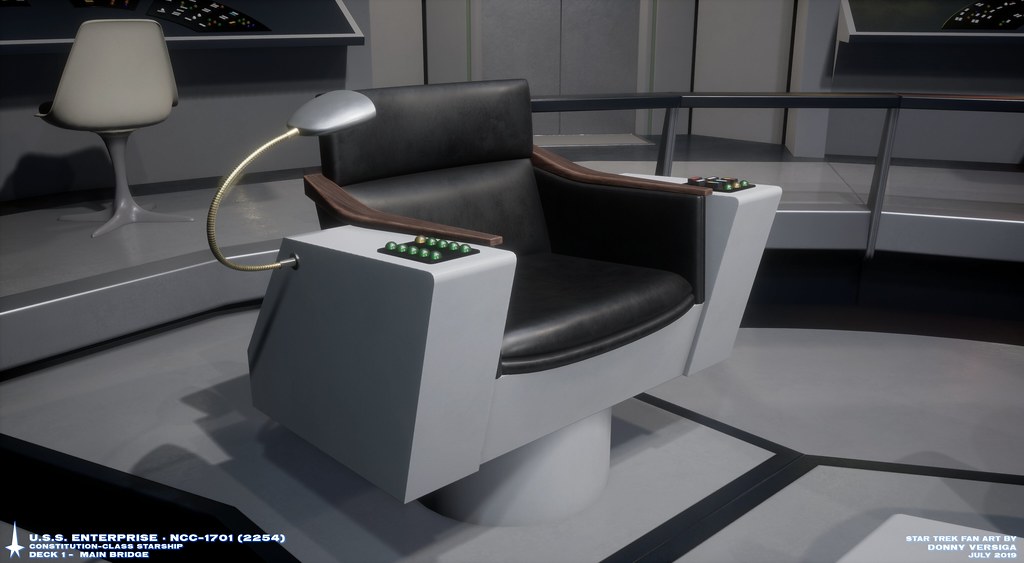
The captain's chair in "The Cage" was not on a raised pedestal like it was in WNMHGB and forward (This detail was something I'd missed until I started doing research for this build!). It looks rather odd so low like this, and I'm glad they eventually decided to raise the Captain up to be higher than the helm and navigator's seats. A goose-neck viewer was attached to the side of the captain's chair, which was later replaced by the intercom unit we saw in the series. The control panels are much simpler than they were later on. There is no slot for a datacard and no rocker switches on either side as well.


The helm was structurally the same as it was in the series proper, but was obviously painted mostly light grey with a blue-black panel top. The center red alert indicator light was shorter and more rectangular than it's wedge-shaped series counterpart. Gooseneck viewers were attached to the astrogator housing itself. The astrogator housing graphic was the same, but did not have the 3-pronged "course indicator" guide that showed up in Season One. Also missing from the astrogator are rocker switches, flat intercom panels, and the ship's chronometer which were all added when the series began it's first season. The control panels themselves were different than they were later on, with rectangular "aircraft-style" buttons instead of the "primsmatic" or "ice-tray" jeweled buttons we saw later on in seasons one and two, respectively. Also missing is the helmsman's pop-up targeting scanner, which appeared in Season 2.

This is the Communications station, which shared a layout similar to most other bridge perimeter stations. The goose neck viewer is present, but notice the lack of rocker switches, flat intercoms, data-card slots and holders. The control panels also follow the "Pilot" scheme, with the aircraft-style buttons instead of primsatic or ice-tray jeweled buttons.

The Science Station was much simpler as well, and is the only time we did not see Spock's beloved hooded scope on this console in the entire run of the series.
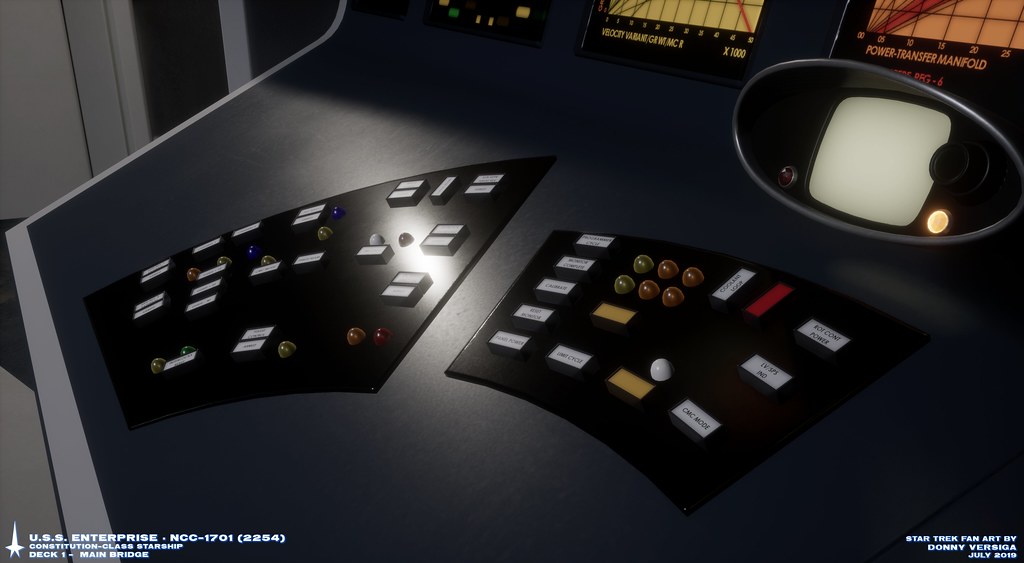
A close-up of the Engineering station's left-hand control panels. Notice the text on the rectangular buttons. A big thanks to @feek61, who was a great help at speeding up my process of making all the unique control panels around the bridge. He put together some great infographics of the panels upon my request for this project, which I used as reference. You can view those infographics on his site!

The stations for Engineering, Environmental, and Engineering Sub-Systems Monitor (ESSM, for short). You'll notice the lack of controls on the ESSM. Control panels at this station were not added until WNMHGB. The similar Defense Sub-Systems Monitor (DSSM), which flanked the starboard side of the viewscreen, never had control panels for the entirety of TOS.

The stations for Navigation, Defense, and Defense Sub-Systems. There stations were not seen in either "The Cage" or "WNMHGB", but we can surmise what they appeared like given their later appearances and following the aesthetic of the rest of the Cage bridge. The ship schematic over the DSSM is purely conjecture.

The turbolift alcove was rather sparse. It lacked a dedication plaque and a red alert indicator as it had from WNMHGB onward. The ship schematic is dimmer and appears almost red instead of orange here. The turbolift doors were painted a slightly reflective silver, and there was a raised panel at the foot of the door. A similar raised panel appears in the transporter room set, so we can surmise that this was a panel that activated the doors when it was stepped upon, instead of motion-controlled like we saw later.

And, once again, instead of coming up with something elaborate for the ceiling (which we never saw on-screen, save for an episode of TAS), I have just gone with something simple. Although the remastered version of "The Cage" implies a transparent dome here, I personally don't believe that the exterior bridge dome was meant to be transparent. In the original non-remastered version, the sequence in which we see the camera go from the exterior of the Enterprise into the bridge seems to be more of a stylistic transition rather than an implication of transparency.
I think that's it for "The Cage" bridge! I'll have the "WNMHGB" screens up shortly!
Last edited:
These are absolutely incredible! I can't believe they're not real starship interiors, nevermind sets.
I really like "The Cage" bridge thanks to your efforts - I hadn't paid it too much heed before, but seeing it devoid of crew and without the fuzziness/graininess shows what a clean, stylish work place it is.
From a 21st century point of view, the only thing I'd change would be to make the viewscreen 'widescreen' (i.e. in place of the panels on either side). I mean, I'd pop back in time and arrange to have a widescreen viewer as part of the set in the 1960s, so when you recreate the sets here in 2019, they include that widescreen
I really like "The Cage" bridge thanks to your efforts - I hadn't paid it too much heed before, but seeing it devoid of crew and without the fuzziness/graininess shows what a clean, stylish work place it is.
From a 21st century point of view, the only thing I'd change would be to make the viewscreen 'widescreen' (i.e. in place of the panels on either side). I mean, I'd pop back in time and arrange to have a widescreen viewer as part of the set in the 1960s, so when you recreate the sets here in 2019, they include that widescreen

Similar threads
- Replies
- 132
- Views
- 4K
- Replies
- 2
- Views
- 477
If you are not already a member then please register an account and join in the discussion!

